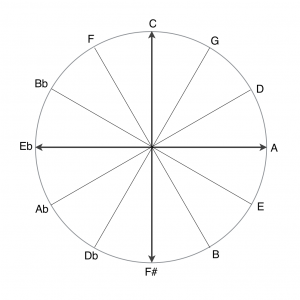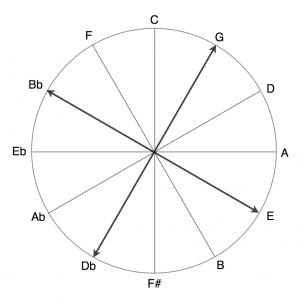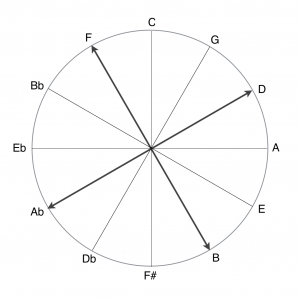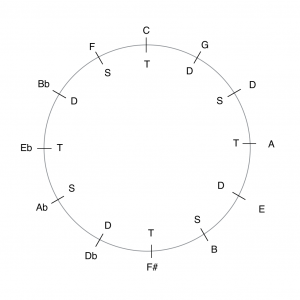Barry Harris' "Brother & Sister Chords", The Four Dominants and Bartok's axis system
Barry Harris in many of his online tutorials refers to ‘The Brother And Sister Chords’ or sometimes ‘The Family Of Four Dominants’. In one of his tutorials he credits Bartok with the original concept. Ernö Lendvai, a student of Bartok in his book ‘Bela Bartok - An Analysis Of His Music’ devised what he called the ‘Axis System’ which forms the basis of Mr Harris’ statements.
Whether we consider the 'idea' to be exclusively Bartok’s or not, or indeed whether HE did, I wanted to explore this idea some more and look at how it has been adopted into the harmonic language used by many, if not most advanced jazz players from Bebop onwards. This system can be illustrated with a modified circle of fifths diagram and follows these guidelines:
- Tonic harmonies in C major are C and Cm, their relatives are Am and Eb and also A and Ebm
- The relatives of those last chords are F# and F#m


The same idea can be applied to chords with the dominant function.
- These are G and Gm, their relatives Bb and Em and also Bbm and Emaj
- The relatives of THOSE chords, which is Db and Dbm


And of course, the same idea can then be applied to chords with the subdominant function.
- These are F and Fm, their relatives Ab and Dm and also Abm and D.
- The relatives of those chords, which is B and Bm.


The relationship between these groups can be represented in this way on the cycle of fifths (S = subdominant, T = tonic and D = dominant):


What this translates to in practical terms, is that on any dominant chord (in functional harmony it's usually a dominant 7th or its derivatives) we can superimpose any chord, major or minor, that's contained within the notes of the dimished 7th chord of that same root. For example, on a C7 chord we can superimpose an Eb, F# or A chords. On a G7 we can superimpose a Bb, Db or E chord and so on.
These polychords are part of the 'upper structure' system which is a complementary system of superimposed chords based on extensions and alterations (more of which in another article). In many cases the left hand will play a minimal harmony underneath the upper structure, eg a 'shell' chord (root & 7th), or a tritone made up of the 3rd and 7th (in either order).
You can watch me talk through this whole concept on my You Tube channel, Jazz Hands Piano, where I also give some practical real-world examples of their use:
If you find this video useful, please give it a 'like' and if you get on with my style of presentation and type of content, please consider subscribing too. If you'd like to get in touch regarding piano lessons, whether jazz or classical, or would like personal tuition in advanced theory, please click through to my contacts page. Happy practising!
ABOUT THE AUTHOR
Gordon Hulbert is a piano/music teacher with a formal classical training at the RCM and LCM and nearly 40 years experience as a musical director and side man with multiple-grammy-winning artists in the pop, rock, soul, light classical, world and electronic arenas. His alter-ego as a composer/producer across multiple genres has produced an impressive body of work – with credits on international TV and feature film soundtracks and on commercial releases in the 90s and noughties by some of Europe’s biggest DJs. He is one of the longest standing members of Heatwave, is musical director for Alison Limerick’s various live projects and plays very selectively around the UK and Europe with his two projects Algorisms and Eat Logic, of which Alison is also a member. With a recording and piano teaching studio based in Notting Hill, London, Gordon moved to the south coast in 2021, where he now lives with his wife and their Norwegian Forest cat.
Gordon’s ‘West London Piano Teacher’ website: http://westlondonpianoteacher.com
Gordon’s ‘London Music Producer’ website: https://londonmusicproducer.com
Algorisms – acoustic jazz with a modern sensibility: http://algorisms.co.uk
Eat Logic – electro-acoustic cross-genre project, informed by jazz, soul, house, drum & bass etc: http://eatlogic.co.uk
